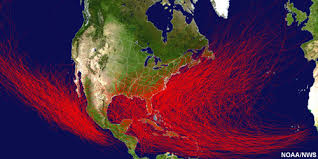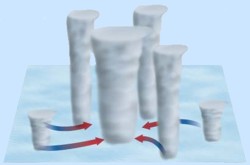| |
The largest and most violent wind and water storms that occur on the Pacific Ocean and Asia are the Typhoons or Cyclons, and Hurricanes in the Atlantic Ocean and Caribbean Sea, so called for the Mayan god of the storms. These macro-storms are nourished by the warm and humid atmosphere of the tropics and characteristic of the zone.

When thehot and humid winds appear near the surface of the sea, they move upwards away from the surface, this causes an area of lower pressure on the surface of the sea.

At the sea surface these air currents take temperature and humidity from around and like in the previous opportunity ascends towards the heights and so closing the cycle. As the warm and humid air rises it cools forming the characteristic the large cumulonimbus type clouds. Progressively as the air circulation increases in the cycle described, the clouds increase in size and begin to turn, always fed by the high temperature of the sea surface. As the system moves and increases in size, an eye forms in the center in which the atmospheric pressure is quite low and the winds are calm and clear, quite the opposite of the surroundings. As the center of low pressure absorbs more air it increases the speed of the wind and progressively increases its strength to become a Hurricane.
The formation of the Hurricanes system is complex, but it requires and overcome a series of stages for reaching an Hurricane. Each stage has its own characteristics and depends on some factors that if not presented, the secuence is interrupted. The main variable of the formation system is the temperature of the sea surface, so when the storm enter the warm waters of the Caribbean Sea, it is posible that an Hurricane can form and move forward within a variable range of intensitires and courses.
Stages of Hurricane Formation
Tropical Wave
Tropical Depression
 |
The Tropical Depression is the inicial phase for the development of a tropical cyclone. Along the process the pressure decreases as the storm increases in intensity. As air flows towards areas of low pressure, takes power from the warm waters of the sea surface and starts the process of rotation due to the Coriolis forces. The winds accelerate up to a maximum of 61,15 miles per hour.  |
In the dynamics of tropical storms it is necessary the presence of other factors such as the formation of a circular winds fields around a closed center, decrease of the pressure, strong convective currents that replace hot air of the center by cooler air that converges from the surroundings, change of water phase in the process of evaporation and then, during the condensation, transformation of the caloric energy into movement.
Tropical Storm

|
The Tropical Storm is already a cyclone or tropical hurricane of low intensity because it presents the typical circular structure as it organize, with a clear hot thermal center. Winds speed can reach maximum of 72.7 m/h and the presence of heavy rains.  |
Hurricane

Imagen traducida al español.
|
When the Tropical Storm has the maximum organization and intensity is considered a Hurricane. It has a center or eye with high temperature and low pressure in the extreme. The winds reach speeds greater than 72.7 m/h.  |
Winds around 200 m/h have been measured in the more intense hurricanes. Its destructive force by the action of the wind and torrential rain is legendary and has been responsible for losses that are counted by thousands.
|
|
|
|
WEB SEARCH



|
|
MASTER SUPPORT
|
|
|